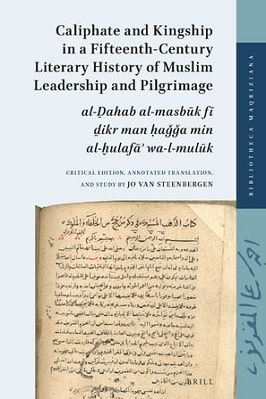
| Book Title | Caliphate And Kingship In A Fifteenth Century Pdf |
| Book Author | Jo Van Steenbergen |
| Total Pages | 511 |
| Book Views | |
| Language | English |
| Book Download | PDF Direct Download Link |
| Get Hardcover | Click for Hard Similar Copy from Amazon |
Caliphate and Kingship in a Fifteenth-Century Literary History of Muslim Leadership and Pilgrimage – al-Ḏahab al-masbūk fī ḏikr man ḥaǧǧa min al-ḫulafāʾ wa-l-mulūk Critical Edition, Annotated Translation, and Study by Jo Van Steenbergen
CALIPHATE AND KINGSHIP IN A FIFTEENTH CENTURY
Book’s Introduction
Number 14 in al-Maqrīzī’s autograph collection of opuscules preserved in the Leiden University library (Leiden, Universiteitsbibliotheek, ms Or. 560, fols. 115b–135a) is a copy of the author’s al-Ḏahab al-masbūk, The Moulded Gold, a summary history of the annual pilgrimage to Mecca since the days of the Prophet.
This is a relatively short text of 40 handwritten pages, also known under the longer title that was later added in the header of this manuscript’s fol. 115b: “The Book of Gold Moulded in the Format of the Report of the Caliphs and Kings Who Performed the Ḥaǧǧ” (Kitāb al-Ḏahab al-masbūk fī ḏikr man ḥaǧǧa min al-ḫulafāʾ wa-l-mulūk).
Discussing issues of caliphate, kingship and Mecca pilgrimage, this al-Ḏahab al-masbūk is in many ways a curious and highly intriguing little text that has so far only attracted limited scholarly attention.1
In accordance with the long-standing status and reputation of the Egyptian scholar, administrator, and judge Aḥmad b. ʿAlī l-Maqrīzī (766–845/c. 1365–1442) as one of the most important historians of his age,2 this attention has mainly considered the text for its historiographical value and for the convenience of its collection of diverse material concerning pilgrimages of illustrious caliphs and many other Muslim rulers.
In a carefully organised chronographic manner this kind of collection allows this “report” to live up entirely to the promise of its longer title and to present all kinds of stories about a substantial list of rulers and their engagements with the ḥaǧǧ, the annual Muslim pilgrimage to Mecca. Starting with the Prophet’s ḥaǧǧ of 10/632 and ending with the story of the Mecca journey in 778/1377 of the Egyptian sultan al-Malik al-Ashraf Shaʿbān (r. 764–778/1363–1377), al-Ḏahab al-masbūk moves from the time of the Prophet, over that of the Caliphs, to that of non-caliphal rulers’ pilgrimage engagements from the eleventh century onwards.
Due to the work’s limited size, however, the added historiographical value of its information about pilgriming Prophet, caliphs, and kings is only very limited, and the relative neglect of the text in historical research of the Mecca pilgrimage and of the history of the caliphates and of its successor polities is therefore perfectly understandable.
The booklet is rather more remarkable for other reasons, not in the least from a wider literary point of view as the very first to claim to offer a more or less focused stand-alone narrative of Muslim leadership of the pilgrimage.3
As will be argued in this study, the disappointing historiographical nature of al-Ḏahab al-masbūk is actually only one residual dimension of a text that was constructed in this unique manner for far more complex purposes.
It is the complexity of these particular purposes and their concomitant literary construction that makes the text so curious, intriguing, and valuable. This has to do with an author who tries to consciously communicate through his text with changing audiences.
It also has to do with the larger contexts within which all three communicative partners—author, text and audiences—operated. In the early decades of the fifteenth century, these contexts were defined by substantial political, socio-economic, and cultural transformations.
They were also shaped by ongoing intellectual debates about the proper social order that should accommodate such transformations.
At moments such as these, stories about pilgriming rulers represented very useful material for a scholar-author such as al-Maqrīzī. Many centuries of Muslim rulers’ engagements with the annual pilgrimage to Mecca turned out to have produced powerful symbolic literary tools to speak about much wider issues of Muslim leadership duties and privileges.
Al-Ḏahab al-masbūk and its particular engagement with the metaphorical options that its subject matter offered were therefore certainly also about al-Maqrīzī’s personal experience of the transformations of his time, his participation in at least some of the debates that were raging, and his pursuance of some kind of impact on various people around him.
All of these issues matter for a proper understanding of the full complexity of a literary text such as al-Maqrīzī’s al-Ḏahab al-masbūk. This book, consisting of a detailed analysis, a new critical edition, and an annotated translation of the text, wishes to present this type of comprehensive understanding.
Its first part presents the first thorough study of the text, conceptualised here as the reconstruction of a kind of cultural biography of al-Ḏahab al-masbūk, in its changing material and immaterial manifestations from its early fifteenth-century conception onwards.4 It will first pursue a reconstruction of those contexts that
To read more about the Caliphate And Kingship In A Fifteenth Century Pdf book Click the download button below to get it for free
Report broken link
Support this Website
Click here to join our Telegram group for new Books